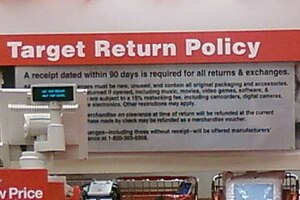Product return: Difference between revisions
Rm useless list entry - write an article first then link it! |
|||
| Line 27: | Line 27: | ||
==See also== |
==See also== |
||
*[[retail equation store list]] |
|||
*[[Lemon law]] |
*[[Lemon law]] |
||
*[[Return merchandise authorization]] |
*[[Return merchandise authorization]] |
||
Revision as of 19:04, 15 September 2013

In retail, returning is the process of a customer taking previously purchased merchandise back to the retailer, and in turn, receiving a cash refund, exchange for another item (identical or different), or a store credit. Many retailers will accept returns provided that the customer has a receipt as a proof of purchase, and that certain other conditions, which depend on the retailer's policies, are met. These may include the merchandise being in a certain condition (possibly being resellable), no more than a certain amount of time having passed since the purchase, or that identification be provided. In some cases, only exchanges or store credit are offered.[1] Some retailers charge a restocking fee for returned merchandise.[1]
While retailers are not usually required to accept returns, laws in many places require retailers to post their return policy in a place where it would be visible to the customer prior to purchase.[2]
In certain countries, such as Australia, consumer rights dictate that under certain situations consumers have a right to demand a refund.[3] These situations include sales that relied on misleading claims, defective goods, and undisclosed conditions of sale.
There are various reasons why customers may wish to return merchandise. These include a change of one's mind, defectiveness of the merchandise, personal dissatisfaction, or a mistaken purchase of the wrong product. For clothing, it may be a lack of a correct fit. Sometimes, there may be a manufacturer's recall in which the manufacturer has requested the merchandise be brought back to the store. Also, gift receipts are offered sometimes when an item is purchased for another person, and the recipient can exchange this item for another item of comparable value or store credit.[4]
Issues
Fraudulent returns
In the United States, various abuses using the return process cost retailers more than $9 billion annually.[5]
One common practice is the use of the system in order to use it to "borrow" the merchandise at no charge. The customer who engages in this practice purchases the item for temporary use, then returns it when finished. Examples include an article of clothing worn for a single occasion, or a book that is returned after it has been read.
Another problem is when customers legitimately purchase an item, then re-enter the store with the receipt, take an identical item off the shelf, and approach the customer service desk requesting a refund. In the process, they essentially receive the item for free.
Others have been reported to print fake receipts which they use to return shoplifted merchandise for a cash refund.
Denying Returns
Some retailers have turned to a practice in which customers who return or exchange items excessively (beyond the guidelines set by a retailer) may be prevented from making a return or exchange with that particular company.
An agency called The Retail Equation (formerly The Return Exchange) collects data from participating retailers via a swipe of a driver's license. The information found on the license is collected into a database, and other stores operated by that particular retail company can use this information to deny a return. This system can be used to prevent various problems, such as return fraud.[5][4]
See also
External links
- The Retail Equation homepage, describes details about the agency and returning
References
- ^ a b Associated Press, "Retailers cracking down on return fraud: Avoid problems returning unwanted gifts during holiday season," MSNBC (Dec . 6, 2006).
- ^ ConsumerAffairs (2004-12-24). "After-Christmas Return Policies Get Stricter". Consumeraffairs.com. Retrieved 2012-11-03.
- ^ "Consumer guarantees - a guide for consumers" (PDF). Accc.gov.au. 2010-12-17. Retrieved 2012-11-03.
- ^ a b "Will I Be Able to Return That Unwanted Holiday Gift? The Retail Equation (formerly The Return Exchange) | Privacy Rights Clearinghouse". Privacyrights.org. 2008-12-12. Retrieved 2012-11-03.
- ^ a b Michelle Singletary, "Return Fraud Earns Retailers' Wrath," The Washington Post (December 10, 2006): F01.
